Coin Ages
by Stephen Huston
2019 First Place
An examination of the development of dating systems on coins from Ancient times to the 20th Century, with emphasis on the evolution of 4-digit year dates.
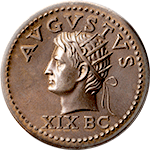
Figure 1
Coin dated 19 BC?
Introduction
We are all used to seeing the date as part of most coinage designs. However, the 4-digit date on coins was not common until the 1600s, and its accuracy wasn’t reliable until less than a century ago.
Where did coin dates come from? How has coin dating changed? What came before? To make sense of modern dates, we need to know a bit about the history of dates in general.
A Short History Quiz
True or False — the Greek king Alexander the Great was born in the Summer of 356 BC.
Almost all scholars agree with the statement that he was, but, had you asked that question at the time, people would have looked at you as if you were insane. Who is this “Alexander the Great” of whom you speak? What is a “Greek King?” What does “356 BC” mean? None of these concepts existed at the time; they were dreamed up centuries later and applied retroactively by historians. Especially the dates.
Alexander was first recorded as “the Great” by Roman writers roughly a century after his death. The very concept of BC/AD dating wasn’t dreamed up until a millennium after Alexander’s death. (The word "millennium" wasn’t coined to mean 1000 years until the 17th Century!)
Obviously BC and AD dating weren’t used to record any events at all in ancient times, and certainly weren’t used on early coinage.
Early Coin Dates
There are many dated or datable coins from before the time of modern calendars, but how did they work?
First off, most early coinage wasn’t dated in any way at all. The few coins that were dated carried year numerals from year 1 onward from a beginning date, whether that was the theoretical founding of a city or kingdom, or the year of a ruler’s reign.
In some cases, the local magistrates’ names or symbols appear on the coinage during their rule, allowing us to figure out their coins’ dates with fair accuracy. In other cases, we can only guesstimate what the coin’s numeric date meant by translating it from a modern calendar system.
For example, a Greek coin issued by a city-state might have a year number written in a local system based on years since the city’s founding. (If we know when it was founded, that helps.) A coin of Julius Caesar carries titles granted to him shortly before his assassination, allowing us to date it very accurately to early 44 BC. Coins of many later emperors carry consul date inscriptions which let us get within a year (or two) based on their known consular appointments. One issue of Roman coins celebrates the 1000th anniversary of the founding of Rome.
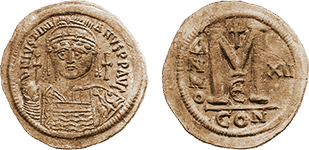
Figure 2
Justinian’s bronze follis of Year 12
dated ANNO XII (538/9 AD)
Later, Byzantine Emperors’ regnal years are a common feature of many Byzantine coins.
The catch is, how to turn these various dating systems into dates on our calendar. Scholars and historians have had to work backwards from modern dates to find points of correspondence with known people and events that can be accurately placed on both dating systems’ timelines, and then make the translation from long-abandoned date systems to the modern calendar. Errors are inevitable — even admitted in many cases — with no further effort to fix them.
For example, some references state that the Babylonian King, Sin-Muballit, abdicated his throne in 1729 BC in favor of his son, Hammurabi. Hammurabi then ruled from 1792 BC to 1750 BC. That is not a typo — his father abdicated in 1729, and Hammurabi then began to rule some 63 years earlier in 1792! (Remember, BC dates run backwards.)
Though this is logically impossible, modern scholars use three conflicting dating systems to describe events of the Babylonian Kingdom, and they simply agree to disagree as to which if them is correct, if any. The information written about one ruler by one scholar can completely conflict with the dating given by another scholar about the corresponding father or son. They simply admit they can’t figure out which chronological system best matches up to the modern calendar because they lack enough verifiable events between the known calendar systems. It’s considered enough that they note which system they are using so that others in the know about this problem can tell why the dates make no sense.
Luckily, as we get closer to modern times, the number of holes in our chronologies shrinks — or does it? Read history, and you will find uncertainty about exactly when things happened.
Consider the discovery that the birth of Jesus most likely fell somewhere around 6 to 4 BC, figured out centuries after the AD system was already in place. How would you go about fixing hundreds of years of work in dating that is all off, and we still aren’t sure by how much? Errors happen — scholars shrug.
When Did AD Begin?
Not with the birth of Christ. The concept of AD and BC dating was dreamed up by a Dark Age monk named Dionysius Exiguus around 525 AD, when he was charged by Pope John I with the task of extending the official Easter Tables. He thought it impious to continue identifying the date of Easter based on the then-current European dating system of the old Roman Emperor Diocletian, who had persecuted the Christians. He decided to calculate backwards to determine the year of Jesus’ birth, make that Year One (1 AD), and then rewrite his entire calendar forward using his new Christian dates.
Even the Pope couldn’t be bothered with this new system. The AD calendar invention was ignored for the next 200 years, though his Easter Tables were used to determine when the Church should celebrate each year.

Fugure 3
Venerable Bede
as depicted in the
Nuremberg Chronicle (1493)
Then, sometime around 735, Venerable Bede produced his Ecclesiastical History of the English Nation, and he adopted Exiguus’ dating system for his Christian history, which brought this “new” dating scheme to the attention of readers. However, Bede wrote in Latin, and his audience was limited to other church scholars.
Around 900 AD, Bede’s work was translated into English, his readership expanded, and eventually the new Christian dating system of Exiguus was adopted by the Papacy in 965, though it was not used with any consistency until after 1050.
At that point, Christianity used a solar calendar based on the birth of Jesus, while Islam used a lunar calendar based on Muhammad’s Hijrah, July 622 AD starting year 1 AH (Anno Hijrah). The AD and AH years neither began on the same date, nor were they of equal length, and they were not the only calendars in use well into the 20th Century AD.
AD Dates on Coins
So one would expect that from sometime in the 1050s, or soon thereafter, coins would begin to have 4-digit AD dates. No. There was another obstacle. Europe still used Roman Numerals to write dates. Adding a date such as 1066 to an English Penny would have required engraving something like MLXVI, though the medieval numerals often used many variations, so 1066 might have come out as: WCXXXXXXVI.
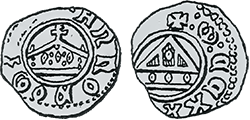
Figure 4
Early coin bearing an AD date
in the 1220s, still written in
Roman Numerals
Classic Roman Numerals for the new AD dates do appear on a few coins in the 1200s, such as WCCXX…. (The M for 1000 appears as a rounded W due to the style of engraving.) That's from one of the earliest AD-dated coins, but the only numerals on-flan indicate a date from 1220 to 1229. The numerals which might have indicated the ones column of the date are either off-flan or non-existant.
Roman Numerals often got harder to write as dates got larger. Imagine trying to engrave dates on a coin die when every year the length of the date changed, requiring somewhere between 2 and 12 letters.
Fibonacci's Arabic Numerals
Enter Fibonacci, an Italian scholar from Pisa, who travelled throughout the Arab world and studied number systems. His medieval Italian name would translate as “Leonardo of Pisa, Son of Bonacci,” but in 1832, western historians began referring to him simply as Fibonacci (Son of Bonacci).
In 1202, Fibonacci published his Liber Abaci, which introduced a base-10 Arabic numbering system to Europe, including a zero as a placeholder. Though it caught on slowly, the simplicity of these numbers appealed to people keeping records and performing calculations, being much simpler for performing math than the old Roman system.
Over the next two centuries, record keeping using Arabic numerals caught on. By the 1400s, 4-digit years were rapidly replacing Roman Numerals in official records, documents, and on coins. Years could be written with just 4 digits for the next several millennia!
Getting on the Same Page
By the 1500s, much of the Western World was using 4-digit dates for years, but only the Catholic Church had officially adopted the AD dating system, and even that was rather half-hearted. Records were usually kept using whatever calendar system was most common in the area. In some towns, that meant records were dated from the year in which the city had been granted rights as a republic by the Holy Roman Emperor, or some other event giving rise to a local “era.” Regnal years still appealed to some rulers. The Western World was a mishmash of local calendars.
Though any of these could be adjusted by someone in the know to determine the official Church-approved date of an event, trying to coordinate dates between two or more local calendars directly could be a major nightmare for anyone unversed in both local systems. Calendars were getting in the way of trade, so religion intervened.
The Gregorian Calendar
Pope Gregory XIII introduced a new calendar in October 1582. His system corrected a 10-day error that had accumulated over the centuries in the older Julian calendar, and it standardized dates with a new leap year system to keep it from getting out of whack again in the foreseeable future.
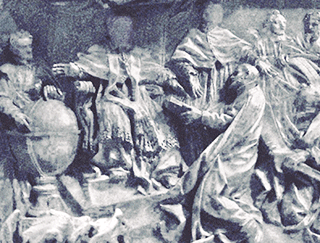
Figure 5
Pope Gregory’s sarcophagus
featuring a scene of him introducing
his new calendar
When the Pope’s decree took effect, October 4th of 1582 was followed the next day by October 15 of 1582, to adjust for the existing discrepancy between the solar year and dates of the Julian calendar. The days of the week flowed through this change without any adjustment or omission. The dates of October 5–14 never existed for 1582. New Years day, the beginning of the new year number, was also moved to January 1st from whatever was previously used before on the various local calendars.
While both practical and the result of many years of scholarly study before being implemented, Gregory’s calendar was still not universally accepted. After all, he was the Pope. By 1582, much of the Western World was no longer Catholic, so anything the Pope did was suspect. He was a religious leader who was messing with the Secular Calendar used by governments and businesses in much of the world.
Now the West had multiple official calendars to pick from, and they disagreed even more than they had before the Pope’s decree. It had suddenly become possible to move from a Catholic area to a Protestant region and discover that while both places agreed on the day of the week, they disagreed about the day of the month, and, in some cases, even about the date of the year itself. New Years day was different among the conflicting systems, January 1, March 22, or March 25. During those Winter weeks, Catholic and Protestant year numbers were different. Even some Catholic countries were slow to adopt the Pope’s new system.
The Calendar Act of 1750
The British World, being officially Protestant, took a long time to realize that they were only hurting themselves by remaining out of sync with most of the Western World. After much consideration and planning, an official Act in 1750 changed the calendar throughout all areas under British rule, including the colonies in North America. This Act changed the New Year date from March 25 to January 1, and removed 11 days from the year 1752 to adjust the old errors and fall into line with dates in the Gregorian Calendar.
The years 1751 and 1752 were both shortened in the process of resetting the calendar:
- 1751 lasted from March 25 (old New Year) to December 31, just 282 days long.
- 1752 began January 1, but Wednesday, September 2 was followed by Thursday, September 14, skipping 11 days, making 1752 only 355 days long.
There was confusion over many local and regional events, religious celebrations, and tax deadlines due to these date disruptions. However, oft-repeated reports of Calendar Riots are a later fabrication. There is no contemporary record of the public anywhere rioting to get their missing days back.
What the Heck is Proleptic?
Those of us born much later fail to realize how much these changes disrupted all existing record keeping systems. The Pope’s Decree in 1582, its gradual adoption in Europe, and the British revision of 1751/52 were legally proleptic in scope. This means that all dates prior to the enactment of the decrees were to be retroactively recalculated in all records as if these rules had been in effect from the beginning of time.
This required that not only the records one kept after the change had to be in line with the new system, but the entire history of the past must be rewritten to assign everything the date it would have had if this system had already been in place at the time it happened, no matter how long ago.
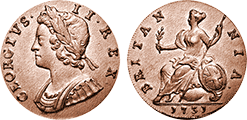
Figure 6
British half-penny of 1731,
the date being struck at the time
of George Washington's birth
Even George Washington was affected.
Washington was born on February 11, 1731. When the Calendar Act of 1750 went into effect, that date was legally changed to February 22, 1732. Not only were 11 days skipped, but the New Year date was moved back to before his birthdate instead of after it. Anyone not aware of the calendar issues would assume his age had been shortened by more than a year!
Now imagine that kind of change being applied to every recorded date in history. Historians faced a daunting challenge. Some of these challenges have caused scholars to simply shrug — again — and make a note that some events are recorded as either OS (old style date) or NS (new style date). It’s simpler than fixing the records the way the decrees required.
The recording of new events was better synchronized, but still there were outlanders — those who just would not keep up — clear into the 20th Century.

Figure 7
Program Cover design for
London 1908 Olympic Games
The London Olympics
In 1908, London was the site of the fourth modern Olympic Games. Unlike the televised versions in later years, these games were scheduled to last several months, beginning in the Spring and running through October. London was a late relocation because Rome, the host city originally selected, cancelled due the eruption of Mount Vesuvius.
The Russian team arrived nearly 2 weeks late for their first scheduled event due to a simple error — Russia was still on the pre-Gregorian calendar, and they hadn’t allowed for the difference in dates. The Olympic events went on without them. Russia still took part in later events, winning some medals, but this error alone wasn’t enough to get them to adopt the modern calendar. Their revolution of 1917 brought a lot of changes, including the adoption of the new calendar by Russia in 1918.
Among other latecomers to the modern calendar were Greece and Turkey, coming around in the 1920s.
The Common Era
Because most of the world now uses one calendar without regard for religious orientation or local traditions, the Gregorian Calendar or AD (Anno Domini) is now often referred to as the "Common Era" or CE for short. In keeping with this secular naming tradition, the period the Pope recognized as BC for Before Christ, is called BCE for "Before the Common Era."
Summary and Final Shrug
The process of moving from regnal years and consular dates written in archaic numeral systems to modern 4-digit dates has been long and slow, with some curious side-steps along the way, including a time when modern AD dates were written in Roman Numerals on coins.
Just remember, when you see a Russian coin dated 1908, it wasn't necessarily struck the same year as a 1908 USA coin. And good luck picking a birth-year coin for George Washington; authorities were actually striking coins dated 1731 when he was born, which the history books now tell us was in 1732…(shrug).
References
- Bickerman, E.J., Chronology of the Ancient World, Cornell University Press, Ithaca NY, 1980
- Frey, Albert R., The Dated European Coinage Prior to 1501, New York, 1914
- Hill, Philip V., The Undated Coins of Rome — A.D. 98–148, Spink & Son Ltd. London, 1970
- Poole, R.S., Catalogue of the Coins of Alexandria and the Nomes, British Museum, 1892
- Whitrow, G.J., Time in History, Oxford University Press (Barnes & Noble edition), 1988
- Wikipedia, searched online at wikipedia.com for these topics:
- Alexander the Great
- Babylonian Kingdom
- Calendar Act of 1750
- Fibonacci
- Gregorian Calendar
- Hammurabi
- Hegira
- Short Chronology
- Sin-Muballit
- Venerable Bede
- 1908 Olympics
Image Credits
- By the Author
- By the Author
- Public Domain, Wikipedia (Venerable Bede)
- Public Domain, from the Albert Frey reference
- Creative Commons Share-Alike License on Wikipedia
- Digital sketch by the author based on various sources
- Public Domain, Wikipedia (1908 Olympics)